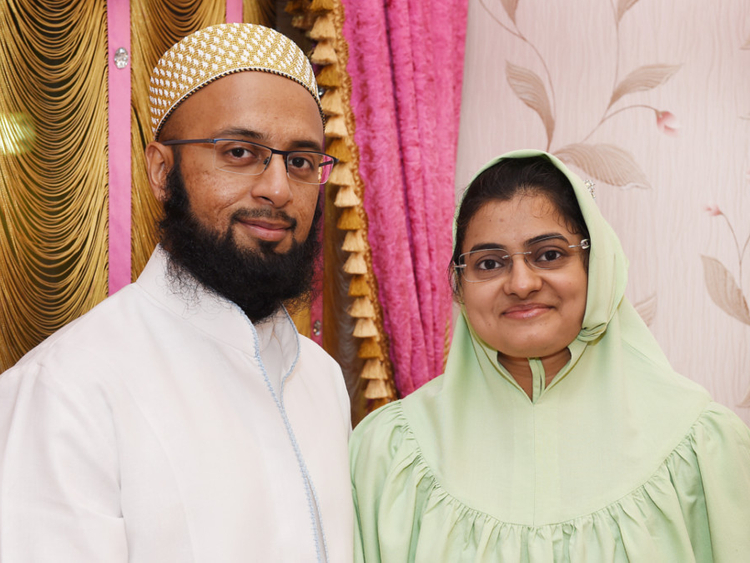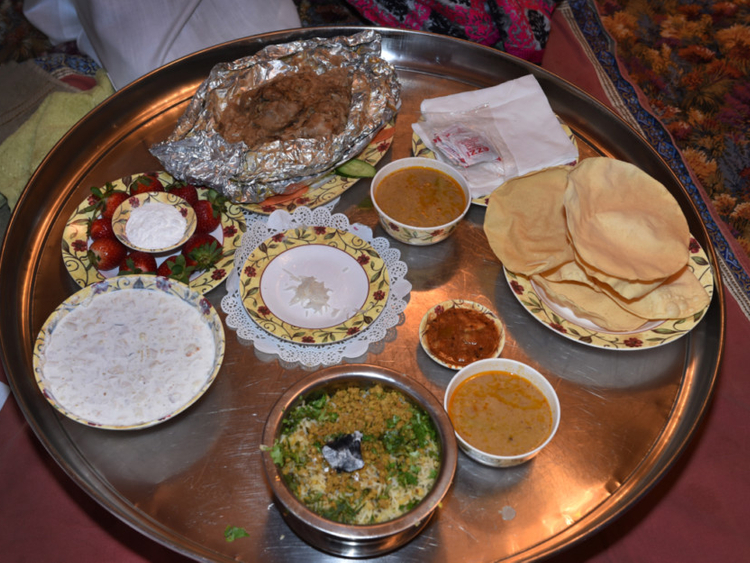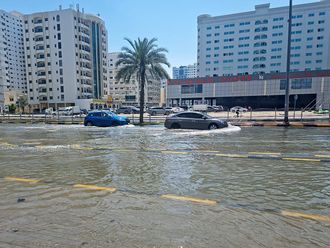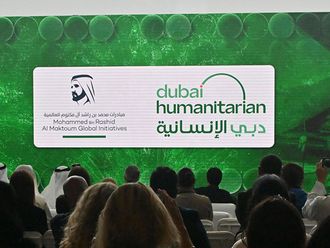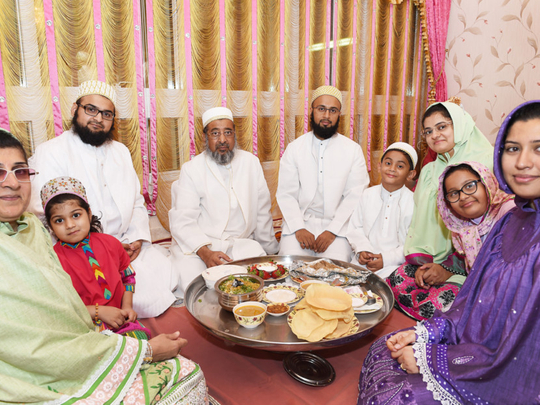
Dubai: At the Dubai home of the Saeeds, from the Bohra Muslim community, iftar is as much about tradition as it is about food.
There is a cultural dimension to almost every part of their daily routine of ending the fast in Ramadan. Bohra Muslims, who are mainly from the Indian state of Gujarat, highly value their culture, closely followed down the generations for centuries.
The Saeeds are a joint family of Mohammad Saeed and his two sons, Ali Asgar Saeed and Mustafa Saeed.
“You could be at any Bohra Muslim family iftar, anywhere in the world, and you would experience the same warmth and culture,” said Ali Asgar Saeed, 35.
As guests arrive, they mingle until it is time to end the fast. Everyone is in traditional attire — the men in crisp white embroidered overcoats (called Saaya) and prayer caps, the women in colourful gowns (called Rida) with matching scarves. Children too are dressed the same way, looking like little versions of their parents.
“The way we end the fast, before the main meal, is actually very simple — just a small glass of warm milk, a date and a biscuit or two,” added Saeed, who was born and brought up in Dubai. He said the combination of milk and dates “are the best options for iftar as they are fairly light and prepare the stomach for dinner”.
After prayers, it is time to eat. Firstly, the hosts bring out a Chilamchi Lota for the guests to wash their hands. The combo consists of a kettle-like utensil to dispense the water and a bucket-like container to collect it as the hands are washed. Chilamchi Lota is also brought out at the end of the meal for hand washing.
“All these good cultural and healthy habits are taught by the Bohra spiritual leader, His Holiness Syedna Mufaddal Saifuddin, to all Bohras around the globe,” Saeed said.
Seated on the plush carpet in the main hall, the guests cluster around huge plates called thaals, with eight people around each thaal — the men on one side of the hall and the women on another.
“There is a sense of closeness and blessing in sitting and eating together like this. Even when just the family eats together, outside Ramadan, we eat like this; even if it’s only four people to a single thaal.”
There were more than half a dozen thaals during the iftar at Saeed’s home. Although iftar gatherings at home are not uncommon, Bohra Muslims mostly visit their main mosque and community centre in Al Nahda in Dubai, throughout Ramadan. As night falls, the traditional iftar unfolds in the same fashion, be it at home or at the centre. There is a big hall at the venue and an estimated 3,000 to 4,000 community members visit the centre for iftar every day in Ramadan.
At the Saeeds, the thaals are carried into the hall and placed on short, round stands (called Chumli) so the plates are a little above the ground, maintaining the honour of the food, and within easy reach. Each thaal is identical, essentially a simple metal plate with a rim. And the food items on each thaal are the same as well.
“We begin and end with a pinch of salt, this is our tradition. It is said that when you start with a pinch of salt, and when you end with a pinch of salt, it gives you healing from 72 diseases,” explained Mustafa Saeed, stealing a moment to chat while busily taking care of his many guests.
Bohra Muslims also have something sweet as a starter, not as a dessert at the end of the meal as is the usual custom in most other cultures. Saeed’s family had prepared a homemade sweet called maleeda, made of flour, jaggery and dry fruit. There is also a Soudhannu — white rice with sugar sprinkled with dry fruit. Another typical starter is a soufflé made with some cake, fruit, crème and dry fruit. Everything is surprisingly light and mildly sweet.
After the starters, two dishes are served — a kharaas and tarkari roti. There are a number of preparations that can take these forms. At the Saeeds at a recent iftar, the kharas was a slow-oven-baked chicken with a paste made mostly of peanut butter, all wrapped inside a foil. The chicken was hot, juicy and a little sweet and salty at the same time, thanks to the paste. Tender to the bone, it fell apart gracefully as guests tucked in.
The tarkari roti is a chicken or mutton dish one has with bread. Again, it can take many forms, as long as it is meaty and eaten with any kind of bread.
After these two dishes, the main meal is served. A hugely popular and very traditional dish of the Bohra community is the DCP, or Daal Chawal Palidu. Daal is yellow lentil, chawal means rice and palidu is a soup-like preparation made from the water used to cook the daal. The rice is like a pilaf with minced meat, garnished with coriander. As the lid is lifted, there is a piece of coal in the centre, burning off the ghee on top of it, for a smoky, buttery flavour. There are a few variations of DCP that use fried rice instead, or a yoghurt-based cold sauce, or hot or cold vegetable soup.
Unlike all the other thaal items, the main dish is topped up as many times as desired. After a pinch of salt, the feast comes to an end. What’s important to note, Saeed said, is that nothing goes to waste.
“We have a zero food waste policy. When the thaal goes back, it goes back empty. In fact, at the community centre, we have a dedicated team that goes around each thaal, encouraging guests to finish all the food. That’s easy to do when you have several people eating together from a thaal. When people eat separately, there is usually some leftovers,” he said.
Abbas Khalil, one of the guests at the Saeeds’ iftar gathering, said: “This is the beauty of our community. We worship together and eat together, whether at home or at the community centre. There is also a conscious effort to avoid overeating and food wastage. All this is combined in the spirit of Ramadan.”
The sense of togetherness is also exemplified at the Saeed residence.
“We are a joint family; my father, mother, my family and my brother’s family living together. We all stay together in one villa because we believe that staying together fosters love and affection,” Saeed said.
Saeed has two children — a 10-year-old daughter named Maria and an eight-year-old son named Adnan. His niece, Zahra, is six.
Saeed’s father, Mohammad Saeed, arrived in the UAE around 45 years ago and started an auto spare parts trading company. “That’s our family’s core business; we’re basically businessmen and traders, from Pratapghar in the Indian state of Rajasthan.”
Box: Star Dish: DCP or Daal Chawal Palidu
Methi 1/2 tsp
Jeera 1/2 tsp
Curry patta (2 sticks)
5 cloves of lasan (chopped)
1 onion (chopped)
Haldi (2 pinch)
Red chillipowder (1/4 tsp)
6 Green chillies full
Kothmeer chopped
2-3 medium tomatoes (cut into 4pcs)
3 tbsp Garam powder
Oil 4 tbsp
Put oil in pan and add methi in it; fry until golden brown. Then add jeera, onion and lasan in it; fry until all becomes golden brown. Add gram flour and stir continuously. Add curry patta, red chillipowder and haldi and slowly add water and keep stirring. Finally add green chilli and tomato.


